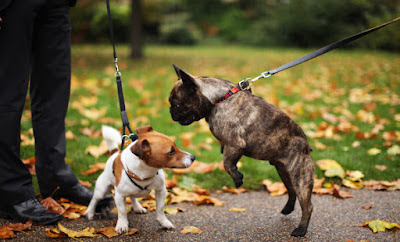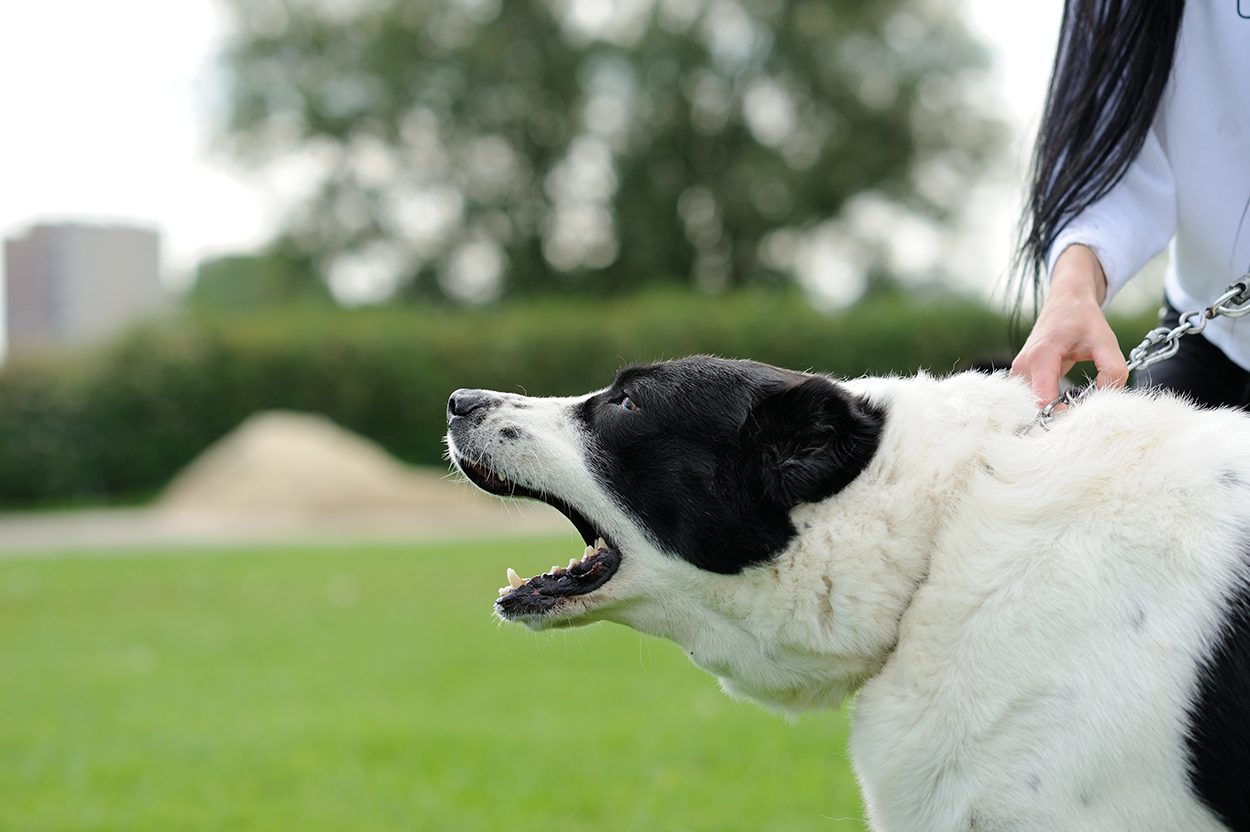Written by
Australian Dog Lover
15:09:00
-
0
Comments
Leash reactive dogs bark, lunge, whine and pull towards other dogs on walks. Some will aggress if given a chance and hurt another dog.Leash reactivity presents in at least two very distinct forms:
- dogs who are reactive on leash but fine off leash or
- dogs who are reactive and do not get on with other dogs off leash either...
For dogs who are generally fine with other dogs, it is a distance decreasing behaviour. These dogs are getting very frustrated by the fact that they are not able/allowed to approach the other dog.
I recently met a dog who was just adopted into a family. She barked and lunged as soon as she saw another dog.
There was no information available if she was okay off leash but the owners were not too keen to try as her on-leash displays looked rather scary!
There was no information available if she was okay off leash but the owners were not too keen to try as her on-leash displays looked rather scary!
A first session on leash was not giving much away as the other (normally neutral) dog was not too sure about her either. This dog clearly had a communication problem. But something just did not add up and I started looking for a potential playmate. It turned out she was social but just had inappropriate manners on leash. Even for professionals, it is not always clear if the behaviour is distance increasing or decreasing which makes it really important to test our assumption before developing a treatment plan.
Why are some dogs reactive on leash?
There are a lot contributing factors that make dogs behave like ‘I am going to kill you’ when on leash. It might be a learnt behaviour, a social dog might have figured out if he behaves like Cujo he will eventually be able to meet, much to the horror of the other dog!
Why are some dogs reactive on leash?
There are a lot contributing factors that make dogs behave like ‘I am going to kill you’ when on leash. It might be a learnt behaviour, a social dog might have figured out if he behaves like Cujo he will eventually be able to meet, much to the horror of the other dog!
Or the dog learns that the lunging and barking will get the other dog to move away. Or limited escape routes make the dog feel scared or trapped by the leash and they are not able to display appropriate body language. Barrier frustration is a build up in frustration because they are prevented from accessing the other dog and interact.
 Puppy to puppy socialisation should facilitate three different skill sets.
Puppy to puppy socialisation should facilitate three different skill sets.
There are times for having a fun play with other dogs, times to just relax in the presence of other dogs and ignoring them and sometimes it is just a quick say hello and keep moving.
Most of these problems are caused by a misunderstanding of what 'dog to dog' or better 'puppy to puppy' socialisations means.
 Puppy to puppy socialisation should facilitate three different skill sets.
Puppy to puppy socialisation should facilitate three different skill sets. There are times for having a fun play with other dogs, times to just relax in the presence of other dogs and ignoring them and sometimes it is just a quick say hello and keep moving.
All three skills should be taught in puppy pre-school. It should be made clear from the very beginning that there is no play interaction if on leash, even for cute puppies. On leash play gives the puppy the wrong information. However, as puppies love to play, they also should have the opportunity to play with other puppies off leash.
Once the puppy is a bit older and walks on a leash, the main contributing factor is that we make our dogs meet every other dog they see in the street (and very often head on). Yes, it might be cute while the puppy is still very young but once the ‘puppy license’ has expired there will be trouble, as older dogs will not put up with out of control teenage dogs in their face.
We assume this to be socialisation and a proper way of meeting dogs. It is not!
If dogs meet unrestrained by leashes they will do the ‘bum sniff’, use circular motion or meet sidewise.
A head-on approach is confrontational. To make things worse we will reprimand a dog, who is a bit unsure about other dogs and wants to get away or growls. This will quickly escalate and the dog might find meeting other dogs on leash scary.
I personally teach all my dogs that when they are on a leash to go into a heel position when passing other dogs and ignore them.
Depending into which category the dog fits, the approach to deal with the problem is different.
How to deal with a dog social off leash but reactive on leash ...
These dogs have to learn that they cannot interact with every single dog they meet and alternative more appropriate behaviours need to be taught. As with most problems, prevention is much better than cure. A puppy pre-school that caters to the three skill sets (fun play, relaxed/ignore, quick hellos) can make a huge difference to how the dog will behave as an adult.
But if the dog already displays barking and lunging then we have to teach that the leash means no interaction, ever! The environmental cue is the leash which is the distinguishing feature and a pretty clear cue to the dog.
We need to teach the dog to walk on a loose leash and an attention cue to manage passing dogs. Other dogs should become a cue to go into a close (or heel) position and focus on the owner. All these behaviours will have to be taught out of context (meaning with no other dogs nearby), once they are on cue we then start far away from other dogs so the dog remains under threshold at all times.
We then very gradually decrease distance and eventually will be able to walk calmly past other dogs.
But we also need to cater for their social needs, meaning appropriate off leash interaction with other dogs. This can either be a well run play group, day care or a good off leash area.
Once the dog realises that there are times for play and times for just calmly walking past, it becomes a whole lot easier and dog has now the skills to make the walk more enjoyable again!
How to deal with dogs who do not like other dogs no matter what ...

These dogs need to go through a desensitising counter-conditioning process in addition to the walking on a loose leash and attention cue training. Regardless of what triggers the unwanted response, we need to change the dog’s perception of the other dog.
We then very gradually decrease distance and eventually will be able to walk calmly past other dogs.
But we also need to cater for their social needs, meaning appropriate off leash interaction with other dogs. This can either be a well run play group, day care or a good off leash area.
Once the dog realises that there are times for play and times for just calmly walking past, it becomes a whole lot easier and dog has now the skills to make the walk more enjoyable again!
How to deal with dogs who do not like other dogs no matter what ...

These dogs need to go through a desensitising counter-conditioning process in addition to the walking on a loose leash and attention cue training. Regardless of what triggers the unwanted response, we need to change the dog’s perception of the other dog.
The other dog’s appearance needs to predict a good outcome for the reactive dog. It basically means every time a dog appears you give the dog treats. The treats are contingent on the stimulus being present not the dog being good. It also needs to happen at a distance where the dog can cope with the other dog. If the dog does not take treats you are too close and need to increase distance.
If the dog takes the treats really hard this is a good indication that he is coming close to threshold. Once we have figured out the starting point we do a few sessions at that distance watching body language carefully and then gradually start decreasing distance. It takes patience, careful planning and a good understanding of body language. I compare it to ‘watching paint dry’, it looks like nothing is happening but on a deeper level a lot is going on.
The main mistakes during this process are:
I strongly recommend getting this process started with a qualified and accredited trainer.
A word of warning
The main mistakes during this process are:
- Dog is over threshold.
- Steps are too big or too small (meaning we either do not make progress or the dog is over threshold).
- Too low or high value treats, it is important to find a middle ground as not to override the emotion.
- Paying for being good. This is not operant conditioning this is respondent or classical conditioning.
- Giving the treat before the dog sees the other dog, this will cause the dog to sensitise and the treat will become the predictor of the ‘bad’ thing. This is the exact opposite of what we want.
- Leash tightening or verbal cues such ‘it is ok’ predict the other dog and the dog will start scanning the environment.
- 'Anxiety’ of the owner which travels right down to the dog. As difficult as it may be the handler needs to be calm, cool and collected.
- Not working with set ups. Random walks in the beginning will not work.
I strongly recommend getting this process started with a qualified and accredited trainer.
A word of warning
If you use ‘corrections’ such as yelling, leash corrections etc. You might suppress the behaviour but you have not changed the underlying emotion that triggers the response.
The dog might still feel unsure, threatened, scared or whatever emotion it was. I always compare this to using a pressure cooker: it works as long as the seal holds. If the seal fails you are in for a rude surprise and potentially a dangerous outcome...
 Barbara Hodel has been involved in dog training for the last 16 years. She has completed a Certificate IV in Companion Animal Services and a Diploma in CBST (Canine Behaviour Science and Technology). She’s also a Delta-accredited instructor since 2007.
Barbara Hodel has been involved in dog training for the last 16 years. She has completed a Certificate IV in Companion Animal Services and a Diploma in CBST (Canine Behaviour Science and Technology). She’s also a Delta-accredited instructor since 2007.
She's also the President of the Pet Professional Guild Australia (PPGA).
She has been running Goodog Positive Dog Training on the Northern Beaches Sydney for the last nine years, running classes on all levels as well as workshops and agility fun classes.
www.goodog.com.au
 Barbara Hodel has been involved in dog training for the last 16 years. She has completed a Certificate IV in Companion Animal Services and a Diploma in CBST (Canine Behaviour Science and Technology). She’s also a Delta-accredited instructor since 2007.
Barbara Hodel has been involved in dog training for the last 16 years. She has completed a Certificate IV in Companion Animal Services and a Diploma in CBST (Canine Behaviour Science and Technology). She’s also a Delta-accredited instructor since 2007.She's also the President of the Pet Professional Guild Australia (PPGA).
She has been running Goodog Positive Dog Training on the Northern Beaches Sydney for the last nine years, running classes on all levels as well as workshops and agility fun classes.
www.goodog.com.au











No comments
Post a Comment